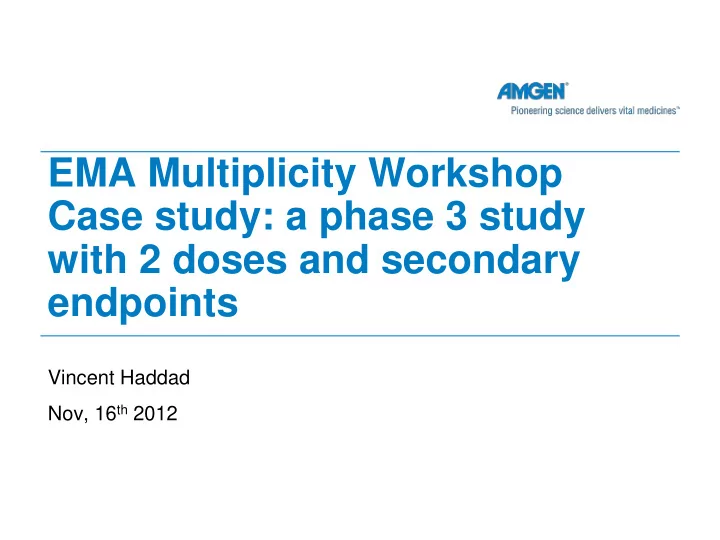

EMA Multiplicity Workshop Case study: a phase 3 study with 2 doses and secondary endpoints Vincent Haddad Nov, 16 th 2012
Agenda • Context • Challenge: maximising power vs. control type 1-error • Separable Multitest Procedures • Different possible strategies for our case study • Our proposal For Internal Use Only. Amgen Confidential. 2
Context: Study Design and Testing Strategy • 3 treatment arms: low dose, high dose and placebo • Primary endpoint: OS, secondary endpoint: PFS • Familywise Error Rate ≤ α (2.5% 1-sided) • Hierarchical logical restriction Low dose vs. placebo High dose vs. placebo Family of assumptions H 11 H 12 F1: primary endpoint Family of assumptions H 21 H 22 F2: secondary endpoint For Internal Use Only. Amgen Confidential. 3
Controling Type 1 Error vs. Maximising Power • For each level of endpoints (family F1 and F2), we want to ensure: FWER= P(Reject at least one true null hypothesis) ≤ α • We also want to maximise the statistical power • Problem: • Closed procedures such as Holm, Hochberg, Fallback and Dunnett cannot hierarchically open the gate to the testing of the secondary endpoints • Only “separable” multiple test procedures can be used as gate keepers. (Cf. Dmitrienko & Tamhane) 4
Separable Multitest Procedures • Explain briefly what it is • Bonferroni or separable mixtures of well-known procedures have been proposed by Dmitrienko & Tamhane For Internal Use Only. Amgen Confidential. 5
Hochberg vs. Bonferroni in our phase 3 • The minimum effect size for the low and high dose vs placebo comparison that can be determined to be statistically significant using Bonferroni is a hazard ratio of 0.82 and 0.79 or absolute median OS increases of approximately 1.3 and 1.5 months. • If none p-value are >0.025, Hochberg allows declaring significant p-value up to 0.025 (instead of 0.0125 for Bonferroni). • This is translated in term of minimum effect size as a hazard ratio of 0.84 and 0.81 or absolute median OS increases of approximately 1.1 and 1.3 months for low and high dose respectively. ⇒ Our clinicians did not want to lose that. For Internal Use Only. Amgen Confidential. 6
Different strategies for our phase 3 Pros Cons Hochberg only Maximise power for primary Does not properly open endpoint the gate for the secondary endpoints Bonferroni Open the gate for the Does not maximise secondary endpoints power Separable Better power than Bonferroni Not well recognised. mixture of Open the gate for the Complexity and freedom procedures secondary endpoints in defining the mixture. Hochberg for Maximise power for primary May lead to an apparent primary endpoint endpoint contradiction: testing Open the gate for the Successful primary Bonferroni as secondary endpoints if small endpoint while no gate keeper enough p-values secondary endpoint testing is allowed For Internal Use Only. Amgen Confidential. 7
Our proposal • We use the Hochberg procedure to test the individual dose groups vs. placebo for the primary endpoint. Then we use the Bonferroni procedure to test the primary endpoint as gate keeper leading to the secondary endpoint testing. • It may lead to a situation with a significant p-value using the Hochberg but not allowing a subsequent test because the Bonferroni procedure may not be significant. In this scenario, the study will be declared successful regarding its primary endpoint while no secondary endpoint formal testing will be performed. • What the EMA would recommend? For Internal Use Only. Amgen Confidential. 8
Recommend
More recommend